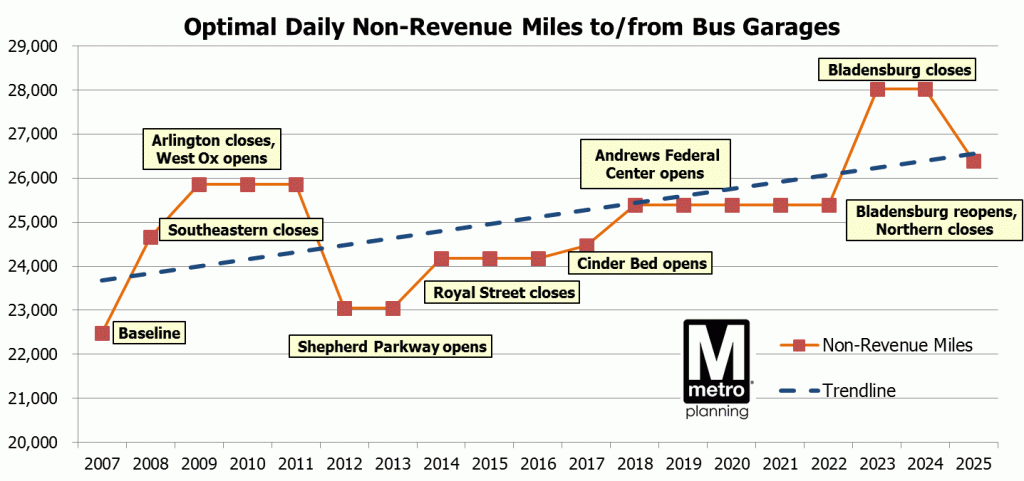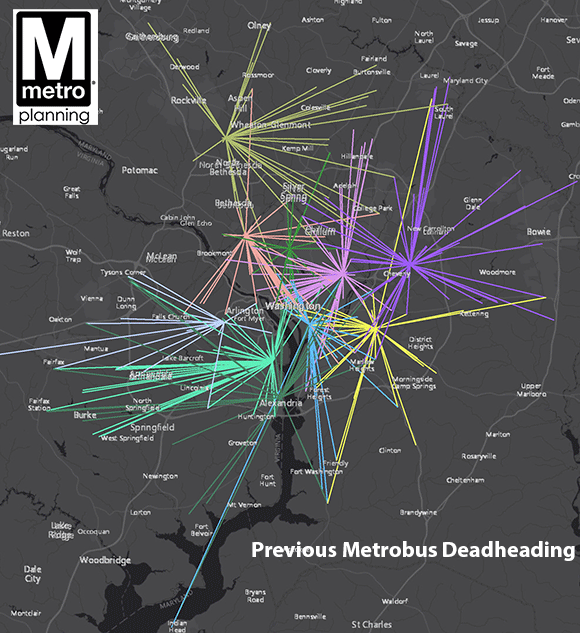The (Hidden) High Cost of Cheap Real Estate
As jurisdictions balance the need to redevelop “prime” Metrobus garage sites, new facilities are located in less desirable and cheaper real estate submarkets. That may sound like great business sense, but it has an impact on non-revenue (or “deadhead”) mileage, creating scheduling challenges and adding millions of dollars in additional operating costs to operate Metrobus service. This trend will increase into the future.
Today, Metro dispatches 1,634 buses for 315 bus routes from only nine bus garages spread throughout Virginia, the District, and Maryland. In a perfect world, Metrobuses would magically appear at the start of a bus route and no additional costs would be incurred. In reality, many bus routes begin far from their assigned bus garages, and travel long distances before they can begin service.
Excluding our two youngest bus divisions (both replacement divisions built in the last five years), the median age of our bus divisions is 61.5 years. These facilities need more than just tender loving care to keep up with today’s service demands. For example, older garages are not equipped to deal with modern buses (the 70-year-old Royal Street bus division was literally too short for modern buses). And only two garages, Four Mile Run in south Arlington and Bladensburg in northeast DC, are equipped to handle Metro’s 457 compressed natural gas (CNG) buses. So often times Metrobus needs new facilities despite the tantalizing prospect of simply refurbishing old ones. These new facilities fall under the category of “LULU” – Locally Unwanted Land Use. Many do not want to live near a bus division, but if the region wants bus service, we need bus garages.
So, bus divisions get pushed out farther and farther from central locations and the neighborhoods where the customers are. All sounds logical so far, except for the fact that the buses now need to travel further to start revenue service. All of this extra journey time simply to get from the division to the customer adds extra deadhead miles to each route. That deadhead is now starting to cost big bucks.
Since 2007, Metrobus’ total operating costs have increased $5 million to cover an increase of 1,700 daily deadhead miles. Closures of bus divisions have had a large impact on operations, steadily increasing daily deadhead miles from the 22,500 mile baseline. The 2008 closure of Southeastern Bus Division (now the Half Street Fairgrounds) as part of the Navy Yard/Nats Park redevelopment caused daily deadhead miles to jump nearly 2,200 miles. Most of the remaining DC garages and Southern were forced over their normal capacity limits, and some service was shifted to Montgomery Division. A year later, the World War II-era Arlington bus division closed and capacity was shifted to the new West Ox Division in Fairfax County. Shepherd Parkway Division opened in 2012, 4 years after its predecessor Southeastern closed, bringing overall deadhead miles about 600 miles shy of the 2007 baseline. Two years later, the Royal Street bus division in Alexandria closed, increasing miles once again.
Metro had intended to hold off closing the Royal Street bus division until after the opening of Cinder Bed Road. The project was substantially delayed to accommodate neighborhood concerns, and we were unable to mitigate the 1,127 mile increase in deadhead during the protracted delay.
The animated graphic below shows the change in deadheading between 2007 and current.
By 2025, a series of facility projects now underway will increase deadhead miles by 8% resulting in $6 million in additional annual costs.
Although deadhead miles are expected to hold steady at just under 24,200 for the next couple of years, the opening of Cinder Bed Road (Royal Street’s replacement) and Andrews Federal Center bus divisions in 2017 and 2018 will drive up miles once again. In 2023, Bladensburg, Metro’s largest bus garage, will close for a 2-year reconstruction. This reconstruction closure is only possible with the opening of Andrews Federal Center, as it will replace Bladensburg as the location for the heavy overhaul facility. When Bladensburg reopens, it will be followed by the closure of the 118 year old Northern Bus Division.
Though it might be a LULU, a conveniently located garage means fewer deadhead miles and lower costs, which is good for Metro and for customers alike – and it keeps Metro’s operating costs down, lowering the subsidy burden on jurisdictions. As we plan for the future of Metrobus, the ongoing operating cost impacts of garage relocations should play a role in how these decisions are made.
What other solutions can you think of for locating Metrobus facilities closer to routes and reducing deadhead costs?




I saw a bus garage in West Hollywood that was located under an office building. I don’t know the details, but LA’s Metro seems to have figured this out.
A $5 milion increase since 2007 works out to an average of $625,000/year in incremental costs. Is that much (or more) saved annually vs. closer in storage facilities? If so, this may not be a problem.
There’s no point in bringing up the cost of a business decision without concurrently bringing up the benefits of that same decision.
Now I understand why the bus operators on my neighborhood routes (17B/H/L) frequently skip the last 2-3 miles of their assigned routes. They have a longer way back to the garage than they did years ago. The closest garage, West Ox is 7 miles from the start of any of our routes while some buses come the Sheppard Pkwy garage over 18 miles away. That’s a lot of money spent on deadheading every weekday.
The great irony here is that WMATA staff supported the move out of Southern garage to a new location much further away from the routes served by the garage. Tearing down and rebuilding Southern garage in-place would have been a much better option for the bus riders and taxpayers of the region.
Not without it’s challenges but has any thought been put into try to work with some of the larger planned(potential) developments in the city: Walter Reed, MacMillan/Old Soldiers Home, reservation 13/RFK, PEPCO site, etc? Ideally it would be incorporated into a commercial zone as I imagine there would be too much opposition to the bus operations early and late in residential areas.
I suppose there is scale economy for the facilities. The larger the size of facility, the lower the unit cost of operation. At the same time, larger lots are harder to find in inner-cities, as facilities are treated as LULU. Citing new facilities further in suburbs and exurbs increase the level of deadhead. This is such a dilemma. While we think of long deadhead for buses, this probably leads to longer commutes for WMATA employees as well.
At this point, integration of citing these facilities in larger developments (more of public developments and toward commercial ones if not light industrial ones), as BTA suggest, sounds an idea for consideration. Especially if the scale economy is not substantial, it may be easy to set up arrangements to hold buses not in operation and buses can take turns to go to maintenance yards for maintenance when necessary — just like us bringing our private vehicles to mechanics.
While old diesel buses are certainly disliked due to substantial vehicle emissions, will substantially lower emissions that may be realized by new vehicle technology help reduce oppositions against citing these facilities?